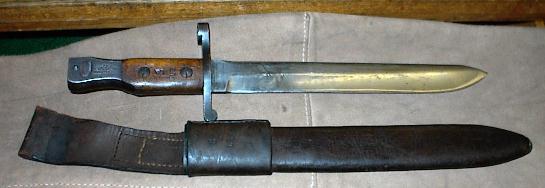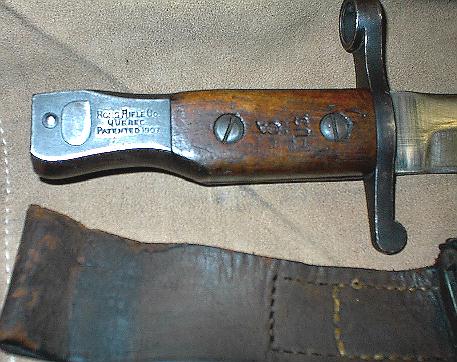
This is a knife bayonet from the period of 1908 into WWI; neither the Ross rifle
nor the bayonet were ever formally adopted by the US military. The US Model 1903
Springfield was officially adopted as it was superior in field trials.
Except for markings, it is virtually identical to the
Canadian Ross Model 1910 Mark II.
Canada formally adopted the Ross rifle in 1905. However, the Ross was not originally
equipped to allow attachment of a bayonet. The bayonet was officially adopted in 1908 -
although patented prior to that in 1907 - but was not issued in Canada until 1910.
These bear the distinctive markings: ROSS RIFLE CO. / QUEBEC / PATENTED 1907 on the
pommel, right (obverse); various acceptance/inspection marks can be found on the
left side (reverse). These marks usually consist of: 2-digit date of manufacture;
an "arrowhead shape in a circle," the Canadian Government Ownership Mark; a
"crown over a number" is a Ross Factory Inspection mark; and an issue date, i.e.
8/10 (August 1910).
About 20,000 of these bayonets and rifles were held by the US military to be
used by home guard(s). US bayonets will bear both Canadian and US markings (ordnance bomb over
US).
The .303 Ross Rifle and Bayonet were mainly used by Canadian units in WWI from
about 1914 to 1918. They were phased-out - when possible - by the .303 Lee-Enfield
Rifle and Bayonet.
Hilt has an oddly "squared" steel pommel with integral push-button/internal-spring latching mechanism.
The muzzle-ring is extended on the Mark I and employs an integral flat spring; steel
crossguard with upper half being a muzzle-ring, lower half being a quillon with flat drum finial.
Single-edged, knife blade is un-fullered; there are at least three accepted variants.
The scabbards are brown leather.
Typical US markings on grip
